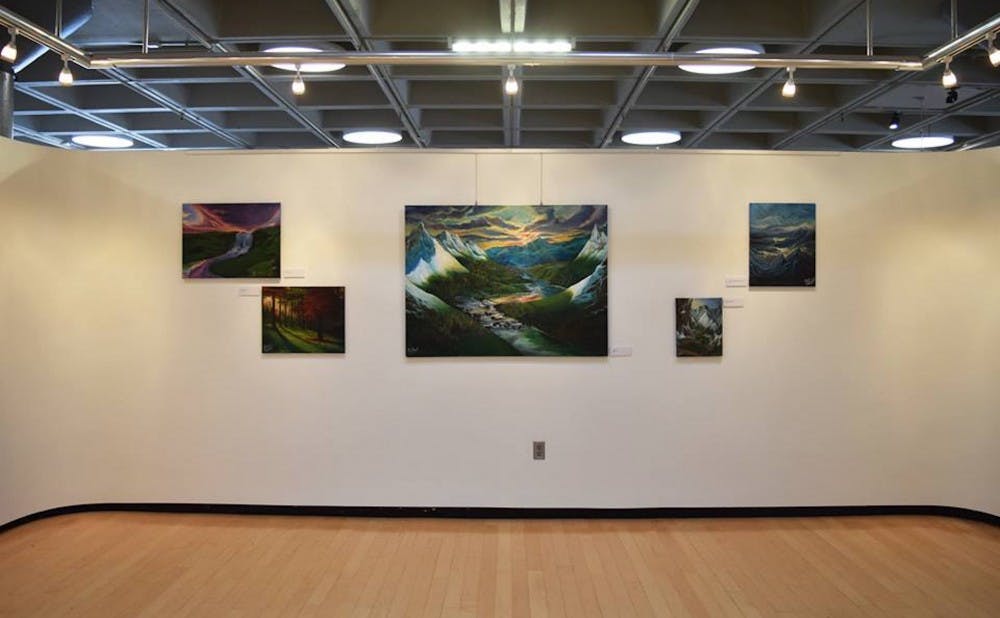On March 12, senior Kelsey Graywill’s visual art showcase “Makings of a Mind” at Louise Jones Brown Gallery concluded its exhibition. The exhibit displayed Graywill’s landscape paintings, which she created as a part of the work for her Program II major, “Creating Meaning: Evolutionary Neuroaesthetics.”
Although some of the works were from Graywill’s senior year of high school, when she first began to paint, she created most of them throughout her undergraduate years at Duke, especially during breaks, when she had more time to sit and paint. She said she finished most of the paintings in a few hours, without even looking at her phone or eating while working on them.
“I do art very quickly,” she said. “If I start a piece, I sit down and finish it.”
But to work on larger pieces, she divided her work into two or three “big sittings.” She worked on a painting for two days over winter break and finished it after coming back to Duke.
With the collection of paintings that she accumulated over the past five years, Graywill designed the exhibit and chose the works to be displayed in it.
Although she had experimented with various forms of art ranging from music to photography, she eventually chose painting as her primary medium. Interested in piano music in high school, she was originally drawn to the integration of music and neuroscience and wanted to discover why people created music and why music was pleasurable to people. But because of her tight schedule at Duke and difficulty in accessing a piano on campus, she ended up with working mainly with visual art forms.
Landscapes particularly appealed to Graywill as one of the oldest subjects of paintings.
“It is something that has a very entrenched presence in the history of art,” Graywill said. “I wanted to take [landscape] as my illustration of aesthetic perception.”
As a self-taught artist, Graywill said her landscape paintings were different from those by other artists because she saw her subjects as a “layperson,” without formal artistic training. She captured in her paintings elements from landscapes that may draw people’s attention and resonate within them, such as the sunset on the beach and the shadows with different shapes that leaves cast on the ground.
“Those are things that people take [pictures of] and post on Instagram,” she said.
Graywill never used pictures that she found on the Internet for her works. Instead, she got the inspirations for her paintings from her experiences of living in areas with different natural settings, like oceans in Florida, mountains in Colorado and forests in North Carolina. On the bus, she would see unique combinations of the colors of leaves on campus in fall and paint her impression of them.
“Those images stick in my mind and I incorporate them later in my paintings,” she said.
Graywill’s exhibit was also notable for her new attempt to juxtapose interactive activities to her paintings. Through the activities, involving diverse senses like sight and touch, she wanted to make the viewers remember the exhibit better and understand its meanings in their own ways. In one part of the gallery, visitors could take a sticker coded to each painting and place it on a graph with adjectives like “anxious” and “joyful” based on their initial responses to the painting.
“I wanted … people [to have] a chance to think a little bit more closely about what their innate, gut responses to the paintings are,” she said.
Graywill said one of the issues that she addressed in her exhibit was the illusion of the objectivity of science, which, in the end, is a discipline developed by humans with limited ability to perceive the world. She hoped the viewers realized that not everything scientists present is the absolute reality.
“People think that science is very objective and that things that are measurable by science are reality,” she said. “But we can only measure things we have tools to measure.”
She also emphasized the role of art and humanities as other tools to view and understand the world.
“There is so much that we do not have accounted for in our understanding of the world and our lives that it makes art even more important,” she said. “Art and humanities can fill in those gaps in our knowledge and our understanding of what human experience is, what life is and how it works.”
Although her exhibition ended, Graywill wanted Duke students to continue to search for the ways in which arts and sciences can be integrated.
“In a traditional university setting like this, where we have … schools that separate humanities from engineering and life sciences, … we get into this way of thinking where they are just seen as totally diametrically opposed studies,” she said. “But I really think that [both] art and science are about discovering and exploring the world.”
Get The Chronicle straight to your inbox
Signup for our weekly newsletter. Cancel at any time.

